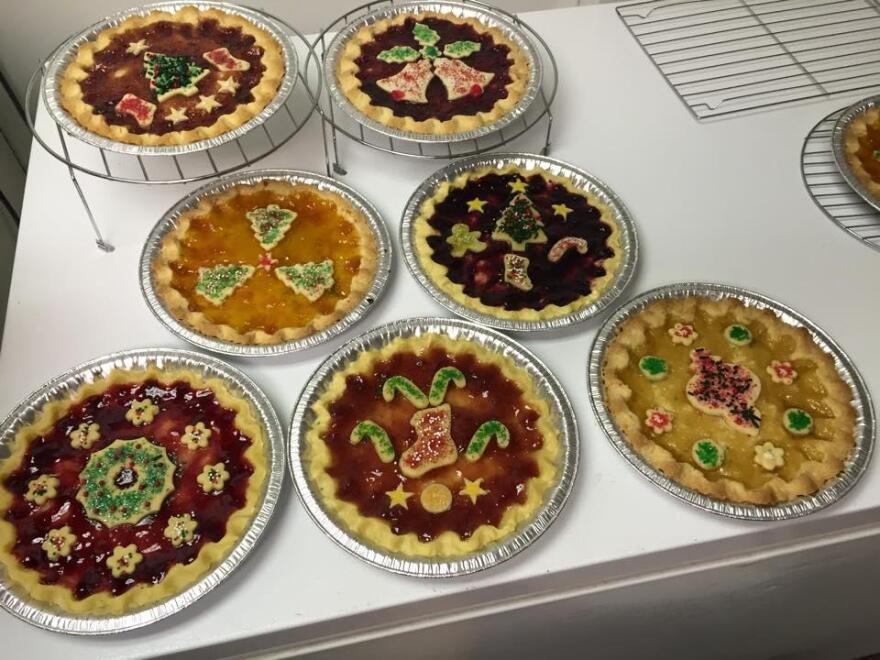Everyone has holiday food traditions that can be traced to individuals or to family ethnicity or nationality, and sometimes to a wider community. Every Christmas I can remember I’ve eaten pasta frolla, which is a dessert associated with Barre, and which I love in the way that Pee-wee Herman loved fruit salad, which is to say that I’d marry it if I could.
Technically, pasta frolla is an Italian shortbread crust. Google it and you’ll find plenty of instructional videos. But in Barre, pasta frolla refers to a specific dessert: shortbread crust smooshed into a pie dish, topped with jelly (like apple, apricot, or red currant) and baked in the oven. Italian women made it in Barre after they came with their families to work in the burgeoning granite industry at the turn of the 20th century. Sometimes you can even find a recent obituary that mentions a Barre Italian woman’s Christmas pasta frolla. Pasta frolla similarly made its way to Argentina as part of the Italian diaspora, where it remains a cultural dish.
Italian immigrants were dedicated to food. Historians like Hasia Diner have written about how the pervasive hunger and class divisions in Italy motivated Italians newly-arrived in the U.S. to prioritize food. Italians spent more money on food than other immigrant groups did, and they imported items and started their own American food businesses – creating a uniquely Italian-American cuisine in the process.
Pasta frolla spread in Barre because the children of immigrants from different countries attended school together and then intermarried, creating mixed-ethnic households – and because pasta frolla showed up in community cookbooks and at church events, and was adopted by non-Italians.

The earliest cookbooks in the Barre collection at the Vermont Historical Society, published between 1895 and 1916, feature recipes from women like Mrs. Smith, Holden, and Abbott. But by 1946 Italian women’s recipes – including two for pasta frolla – were heavily featured in a Barre cookbook, and they have been ever since. The most recent cookbook in the collection is from 2011; and, yes, it includes a pasta frolla recipe.
Historians like Ardis Cameron have credited immigrant women for spreading food traditions by sharing recipes across cultural lines. That practice continues, so that my family’s pasta frolla comes from my mother (not Italian) who learned it from an Italian neighbor woman with a Spanish last name. Similarly, my friend’s Canadian, non-Italian aunt moved to Barre, discovered pasta frolla, and makes it every Christmas.
These days I don’t live in Barre, but my daughter requests pasta frolla, and so the tradition continues.
Pasta frolla
Recipe courtesy of Edith Fontana Gomez, Barre
- 2 sticks soft butter
- 1 cup sugar
- 2 cups flour
- 3 egg yolks
- 1 egg white
- 1-2 teaspoons vanilla or brandy or other flavoring
- Apricot jelly or preserves
Makes 2 pies
Directions: Cream butter and sugar. Add eggs and flavoring. Add flour. Divide in half and smooth into 2 pie dishes. Flute edges. Spread jelly on dough and bake c. 30-45 minutes (check at 20 minutes to be sure it's not burning) at 325.
Alternate recipe, from Jill Mudgett
Cream together 1 stick soft butter and 1/2 cup sugar. Add 2 egg yolks and 1/2 teaspoon all/any of the following: vanilla, almond, lemon, orange extracts. Blend in 1 1/2 cups sifted flour. (Form dough crumbles into ball.) Smooth into pie dish. Whisk red currant jelly with fork and spread on dough. Bake at 325 for 20-25 minutes (check that it doesn't burn).
Any extra dough can be used as lattice work or other decoration on top of jelly.





